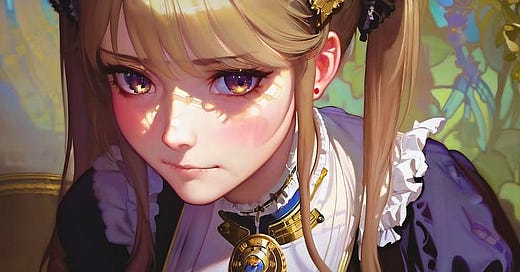Dear readers, as you know (I hope), I write a lot about otaku culture and have even published a couple of books about the subject. The big thing currently happening in the comic and animation industry is the advent of artificial intelligence and how it can be used to create art. This is not only a big game changer but it poses a serious threat to traditional creators. Today I’m sharing an interesting article I found on the subject.
There are growing concerns that artificial intelligence could mean that would-be artists today don't have to be the next Picasso to create lucrative pieces.
Until recently, AI systems could create only questionable works of art, but their quality is rapidly nearing that of paintings for commercial sale.
Creators are fearing their AI counterparts may violate their rights or deprive them of jobs, as detailed countermeasures have yet to emerge under existing legislation.
RIFT ALREADY STARTING
Yamaoka Tomoko, 57, a resident of Chiba Prefecture close to Tokyo, began making illustrations with an AI image generator late last year.
Yamaoka, who had not painted by hand since her high school days, made the decision after being astonished by a video showing the completion of a painting with AI “as quickly as taking a photo.”
However, she soon learned that rectifying AI-derived pictures took more time than she had expected, with errors, such as two heads added to a single person, cropping up in them.
Her works were also at times rejected on illustration sales websites on the grounds there were already “similar creations.”
Despite this, she was able to register 30 paintings on a few sites within six or so months to earn several hundred yen (several dollars).
An increasing number of AI-based images are being posted online. More than 6 million works by AI can be found on Adobe Stock, an image storage platform operated by Adobe Inc. in the United States.
However, some unauthorized data is also used when training AI to create art.
There have already been some reported cases of third parties allegedly using someone else’s name and pretending to be them by imitating the creators’ painting styles with the help of AI illustrators.
Concerns are growing among creators.
According to the findings of an online questionnaire survey Arts Workers Japan conducted on 26,891 respondents in May, 93.8% of illustrators, novelists, photographers, video game creators and others said they were “worried” about potential rights infringements and other negative effects of AI.
Asked whether they feared the likelihood of the spread of AI leading to fewer job opportunities for them, 58.5% said “yes.”
Manga artist Shinofusa Rokuro was first alarmed by generative AI last summer. AI painters were still significantly unskilled at the time, but their imaging speed far exceeded that of human artists.
Shinofusa recalled thinking that illustrators could be fired if such AI-generated images were more broadly used and such an impact would be felt the most on younger people.
“Artists form their own painting styles over years,” he said. “If their copies prove popular and spread over a few months, people could consume and become tired of them in an instant. Creators would then lose their desire to create art.”
Illustrator Shimizu Yo acknowledged AI can serve as an efficient tool to step up productivity if used properly but strongly questioned the recent situation where pieces of art are being used to train AI without the creators’ consent.
“The relationship of trust between AI developers and users and creators is starting to collapse even as we are still at the dawn of generative AI,” said Shimizu, who has worked on a poster for the renowned Doraemon franchise.
“Unless human-first rules are put in place, enthusiasm to create new works will disappear,” Shimizu added. “That would then result in an industry-wide stagnation.”
LEGAL SHORTCOMINGS
Under Japan’s Copyright Law, discussions on AI and copyrights are separately placed into the stages of learning and utilization.
Copyrighted materials can be used for learning without their owners’ permission, except for instances in which copyright holders’ interests are unreasonably harmed.
In the utilization phase, whether AI-made images constitute copyright infringements is determined based on their similarities to, and reliance on, original creations, just like in ordinary copyright offenses.
The problem lies in the fact that what is identified as illegal remains unclear in both stages.
With these in mind, the government approved its intellectual property strategic program on June 9.
Some issues referred to it include what sort of AI-connected cases shall be regarded as inappropriate or offensive in the learning and utilization processes as well as how much commitment humans must make so their creations based on AI images can be recognized as their own productions.
“It should be widely known to the public that existing intellectual properties’ copyrights are guarded even under the current legal framework from copyright violations by AI-generated works,” said lawyer Ikemura Satoshi, who is knowledgeable about the Copyright Law.
He proposed an additional countermeasure.
“Making it mandatory for AI-derived pieces of art to be labeled as such to be distinguished from humans’ creations would contribute to the protection of creators,” he said.





I still think the real artists will stand out.
Everybody can sample music or take a photo with minimal effort, but not everyone makes good art with it.
Plus anybody can go to a library and learn somebody's stye and copy it.